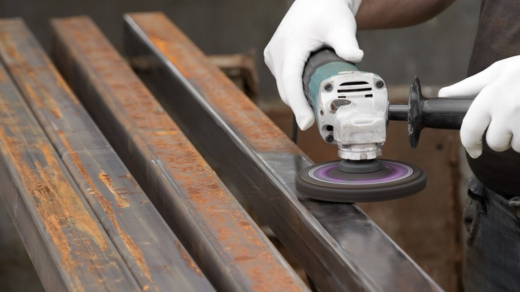Metal polishing is often the unsung hero of many industries. When you think about a shiny, smooth metal surface, it’s easy to assume that it’s a product of advanced manufacturing. But behind that gleaming finish lies a careful process, one that can elevate not only the appearance of the metal but also its performance. Whether you’re restoring an antique, improving the look of your car, or ensuring the longevity of an industrial component, metal polishing is a skill that combines precision, technique, and a little bit of elbow grease.
In this article, we’ll explore what metal polishing is, why it’s important, and how to achieve professional results with a variety of techniques. So, let’s dive into the world of metal polishing, a process that’s as much about functionality as it is about aesthetics.
What is Metal Polishing?
At its core, metal polishing is a process that smooths and shines metal surfaces through abrasive rubbing, buffing, and sometimes chemical treatments. While this may sound like a simple task, it requires a great deal of expertise to achieve a flawless, mirror-like finish without damaging the metal.
Polishing serves multiple purposes beyond making a surface look nice. For one, it helps to remove scratches, dents, and imperfections that can accumulate over time. It also helps to clean metal by eliminating oxidation, rust, or other stains. Additionally, a polished metal surface is often more resistant to corrosion and wear, which makes metal polishing an important part of metal maintenance.
But don’t think it’s just about looks—polishing can also play a functional role in industries like automotive, aerospace, and manufacturing, where precision and performance are crucial.
Why is Metal Polishing Important?
It’s easy to dismiss metal polishing as a purely aesthetic job. But think about your car’s chrome, the shiny surface of kitchen appliances, or even the delicate parts inside a high-tech machine. Every polished metal surface serves more than one purpose:
- Enhanced Durability: By removing contaminants, you’re helping the metal resist corrosion and oxidation. A polished surface is less likely to rust, making it perfect for items exposed to moisture, such as outdoor furniture, marine equipment, or kitchen tools.
- Improved Functionality: A smooth, polished surface ensures less friction. In mechanical parts, this reduces wear and tear, increases efficiency, and extends the lifespan of components. For example, polished metal parts in an engine are less likely to overheat or cause unnecessary friction.
- Aesthetic Appeal: Let’s not forget the visual appeal of polished metal. Whether it’s a beautifully restored classic car, a piece of high-end jewelry, or a perfectly finished kitchen faucet, polished metal surfaces add an undeniable shine that can elevate the look of any product or space.
- Increased Value: In many cases, polished metal surfaces can increase the value of an item. Take, for example, antique furniture or collectible items like coins or watches. A skilled polish can restore or enhance its value by making it more attractive and well-preserved.
Types of Metal Polishing Techniques
There’s more than one way to polish metal, and the technique you use largely depends on the type of metal you’re working with and the desired finish. Let’s take a look at the most common polishing methods.
1. Hand Polishing
Hand polishing is the most basic and time-honored method of metal polishing. It involves using abrasive materials like sandpaper, polishing cloths, or buffing pads to manually rub the metal surface. While this method can be labor-intensive, it allows for a high degree of precision, making it perfect for small or intricate items, such as jewelry or fine metalwork.
Tools you might need for hand polishing include:
- Polishing compound
- Cloth or buffing wheels
- Abrasive sandpaper (often in a range of grits)
2. Machine Polishing
For larger projects, machine polishing is often a better option. This technique involves using powered tools like rotary polishers or buffer machines. These machines spin buffing wheels or pads against the metal surface to smooth it out and create a high-shine finish. It’s much faster than hand polishing and can be applied to large surfaces, such as car bumpers or metal pipes.
Machine polishing is ideal for:
- Larger metal surfaces
- Reducing time and labor
- Achieving a high-gloss finish quickly
3. Electropolishing
Electropolishing is a more advanced and specialized method that uses an electrolytic process to remove surface material from metal. The metal is immersed in a bath of acid while an electrical current is passed through it. This process removes imperfections and smooths the surface, leaving a highly polished, reflective finish.
Electropolishing is commonly used in industries such as:
- Aerospace
- Medical devices (such as surgical instruments)
- Food processing
This technique not only polishes the metal but also enhances its corrosion resistance, making it a great choice for industries that require sanitary, long-lasting components.
4. Chemical Polishing
Chemical polishing uses chemical solutions to remove the outer layer of a metal surface, smoothing out imperfections and enhancing its shine. This method is typically used for metals that can’t be polished using abrasive techniques, such as aluminum and certain alloys.
It’s often used for:
- Parts that are difficult to polish mechanically
- High-volume production environments
Chemical polishing can provide a uniform, smooth finish but is typically used for specific types of metals and applications.
Tips for Effective Metal Polishing
Achieving a high-quality polish doesn’t always come easy, but with the right approach, it’s definitely doable. Here are some tips to help you get the best results:
- Choose the Right Tools: Whether you’re using hand tools or machines, make sure you have the right polishing compounds, pads, and wheels for the specific metal and finish you’re aiming for.
- Work Gradually: Don’t rush the process. Start with a coarse abrasive to remove major scratches and imperfections, then move to finer abrasives to create a smoother finish.
- Clean Between Steps: It’s important to clean the metal surface between polishing steps to remove dust and residue. This will prevent new scratches from forming during the process.
- Protect the Metal: After polishing, you might want to apply a protective layer, such as a wax coating or clear finish, to preserve the shine and prevent future corrosion.
- Safety First: Always wear safety gear, such as gloves, goggles, and dust masks, especially when using power tools or working with chemicals.
Conclusion: The Beauty and Function of Metal Polishing
Metal polishing is more than just a surface-level task. It’s a skill that adds value, functionality, and aesthetic appeal to everything from industrial parts to fine art. Whether you’re polishing a vintage car part, restoring a family heirloom, or improving the performance of a machine component, this process plays an essential role in both the longevity and appearance of the item.
By understanding the different types of polishing techniques and employing the right methods, anyone can achieve a polished, professional finish on their metal surfaces. So, whether you’re polishing for beauty or function, remember that a little effort and the right tools can go a long way in bringing that shine to life.

